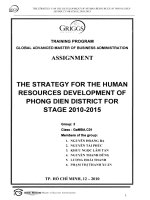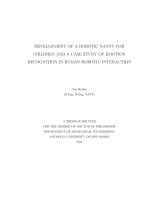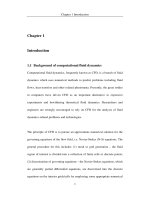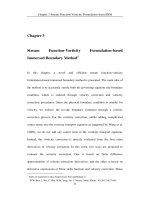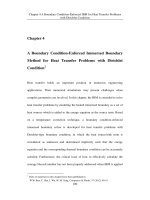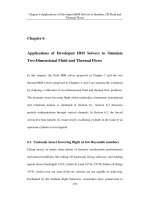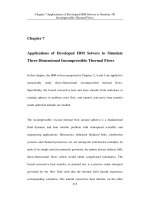Development of improved production technology for existing rice-maize cropping system in Tungabhadra command area
Bạn đang xem bản rút gọn của tài liệu. Xem và tải ngay bản đầy đủ của tài liệu tại đây (216.25 KB, 8 trang )
Int.J.Curr.Microbiol.App.Sci (2019) 8(2): 1310-1317
International Journal of Current Microbiology and Applied Sciences
ISSN: 2319-7706 Volume 8 Number 02 (2019)
Journal homepage:
Original Research Article
/>
Development of Improved Production Technology for Existing Rice-Maize
Cropping System in Tungabhadra Command Area
Mallareddy*, B.K. Desai and B.G. Koppalkar
Department of Agronomy, UAS, Raichur-584 104 (Karnataka), India
*Corresponding author
ABSTRACT
Keywords
Rice-Maize
Cropping System
Article Info
Accepted:
12 January 2019
Available Online:
10 February 2019
Traditional agricultural practices have resulted in decreased soil fertility, shortage of water
resources and deterioration of agricultural ecological environment, which are seriously
affecting production of maize. A field experiment was conducted in medium black soil
during kharif and rabi season of 2016-17 and 2017-18 at farmer field near Agricultural
Research Station, Sirguppa. The results revealed that, among improved production
technologies of maize, higher grain yield were noticed with improved method-4 (T5: 7681
kg ha-1) over farmer method of cultivation (T 1:5840 kg ha-1). The magnitude of
improvement in grain yield of maize by improved method-4 (Minimum tillage, herbicide
and 100% fertilizers application) was to the tune of 31.52 per cent over farmer method of
cultivation. Improved production technology showed lower penetration resistance and
higher soil moisture content as compared to existing rice-maize cropping system.
Introduction
Tungabhadra Project (TBP) and Upper
Krishna Project (UKP) command areas are
one of the major rice producing regions of
Karnataka. Where about 5.78 lakh ha of rice
is grown, which are referred to as rice bowl of
Karnataka. Farmers of majority of command
area do not go for second crop due to various
reasons and spatial distribution of these “rice
fallows” is not documented. In recent past
much of this area has single crop per year,
usually Kharif and no crop is grown during
rabi / summer up to the harvest of rice mainly
due to lack of irrigation especially in tail end
region. These rice fallows represents an
enormous under used resources for crop
diversification and increasing cropping
intensity and production. Traditional low land
rice grown with continuous flooding in Asia
has relatively required high water input.
Since, the rice is cultivated under
continuously flooded ecosystem and it is
associated with sequestration of N in resistant
lignin compounds formed from the large
amounts of retained crop residues. Thus, the
farmers are facing difficulty in selection of a
profitable sequence after paddy. Under such
situations, there is ample scope for
introduction of high valued arable crops and
1310
Int.J.Curr.Microbiol.App.Sci (2019) 8(2): 1310-1317
vegetables with the usage of conservation
agricultural techniques or zero tillage
technology which is popular in northern parts
of our country.
In rice-maize cropping system farmers are
practicing intensive tillage practices with
higher dose of fertilizer’s application.
Another important consideration is poor plant
stand of maize in rice fallows resulting in
poor crop establishment, and above all,
pitiable management of crop affects both
biomass production and grain yield. These
reasons could end up in realizing low crop
yield and sometimes, returns were
uneconomical as well and hence, low
coverage of crops in rice fallows. Research
evidence suggests that the crop residue
retention/incorporation has favourable effect
on soil properties (Praharaj et al., 2014).
Thus, resource conservation technology
(RCT) dealing with conservation of soil
moisture, build up of organic matter and
improvement in both soil structure and
microbial population could be an appropriate
approach to address these problems (Praharaj,
2013). In addition, if crop residues are
retained on the soil surface in combination
with suitable planting techniques, it may
possibly alleviate terminal drought condition
in pulses by conserving soil moisture and
bring overall improvement in resource use
and its optimum management. Hence,
minimum soil traffic by adoption of
appropriate technology involving no tillage
and management of crop residues could lead
to favourable effect on soil microbiological
properties that would further enhance the
overall resource use efficiency (RUE) and
productivity capacity of rice fallows.
Materials and Methods
The experiment was conducted in farmer field
near ARS, Siruguppa which is located at
760.54ꞌꞌ E Longitude, 150.38ꞌꞌ N Latitude and at
an elevation of 380 meters from MSL located
under Northern Dry Zone (Region II, Zone-3)
of Karnataka with an average annual rainfall
of 745.23 mm from July to October in about
42 rainy days. The experimental design was a
laid out in randomized complete block design
(RCBD) with 7 treatments [T1: Farmers
method of cultivation, T2: Improved method 1 (Zero till, herbicide and 75% fertilizers
application) T3: Improved method -2 (Zero
till, herbicide and 100% fertilizers
application) T4: Improved method -3
(Minimum tillage, herbicide and 75%
fertilizers application) T5: Improved method 4 (Minimum tillage, herbicide and 100%
fertilizers application)] with 4 replications.
The gross plot size was 5.40 m X 4.80 m and
net plot size was 3.00 m X 4.00 m. The main
objective is to increase maize yield in ricemaize cropping system by adopting improved
production
technologies
like
tillage
management practices with judicious use of
fertilisers and use of herbicides.
Results and Discussion
The data on plant height of maize differed
significantly due to improved production
technology. At 30 DAS, significantly higher
plant height was recorded in improved
method-4 treatment (T5: 29.13 and 30.13 cm,
respectively) followed by improved method-3
(T4:27.15 and 28.15 cm, respectively) and it
was on par with improved method-2 (T3:27.11
and 28.11 cm, respectively) and significantly
lower plant height were recorded in farmer
method of cultivation (T1:22.38 and 23.38 cm,
respectively) in rabi season of 2016-17 and
2017-18.Significantly higher plant height was
recorded at 60 DAS in improved method-4
treatment (T5: 121.85 and 123.95 cm,
respectively) and it was on par with improved
method-2 (T3:118.75 and 120.95 cm,
respectively) and lower plant height were
noticed in farmer method of cultivation
(T1:107.50 and 107.25 cm, respectively)
(Table 1–4).
1311
Int.J.Curr.Microbiol.App.Sci (2019) 8(2): 1310-1317
Table.1 Effect of improved production technology on plant height (cm) of maize in rice-maize cropping system
Treatments
30 DAS
60 DAS
90 DAS
At harvest
2016-17 2017-18 Pooled 2016-17 2017-18 Pooled 2016-17 2017-18 Pooled 2016-17 2017-18 Pooled
T1: Farmers method of
cultivation
22.38
23.38
22.88
107.50 107.25
107.38
150.81 154.32
152.56
155.53 160.28
154.92
T2: Improved method -1 (Zero
till, herbicide and 75%
fertilizers application)
T3: Improved method -2
(Zero till, herbicide and
100% fertilizers
application)
T4: Improved method -3
(Minimum tillage,
herbicide and 75%
fertilizers application)
T5: Improved method -4
(Minimum tillage,
herbicide and 100%
fertilizers application)
25.55
26.55
26.05
116.65 118.85
117.75
163.35 169.88
166.61
168.33 173.43
169.10
27.11
28.11
27.61
118.75 120.95
119.85
169.30 173.82
171.56
171.73 175.63
172.77
27.15
28.15
27.65
115.65 117.85
116.75
163.55 172.05
167.80
167.30 175.93
169.68
29.13
30.13
29.63
121.85 123.95
122.90
173.43 176.88
175.15
175.20 181.23
176.04
S. Em. ±
C.D. (P=0.05)
0.51
1.57
0.51
1.57
0.50
1.56
1.04
3.19
1.41
4.36
1312
1.22
3.77
1.07
3.30
1.20
3.71
1.14
3.51
1.05
3.22
1.21
3.72
1.13
3.47
Int.J.Curr.Microbiol.App.Sci (2019) 8(2): 1310-1317
Table.2 Total dry matter production (g plant-1) at different growth stages of maize as influenced by improved production
technology in rice-maize cropping system
Treatments
T1: Farmers method of
cultivation
T2: Improved method -1 (Zero
till, herbicide and 75%
fertilizers application)
T3: Improved method -2 (Zero
till, herbicide and 100%
fertilizers application)
T4: Improved method -3
(Minimum tillage, herbicide
and 75% fertilizers
application)
T5: Improved method -4
(Minimum tillage,
herbicide and 100%
fertilizers application)
S. Em. ±
C.D. (P=0.05)
30 DAS
60 DAS
90 DAS
2016-17 2017-18
Pooled 2016-17 2017-18
Pooled 2016-17 2017-18
At harvest
Pooled 2016-17 2017-18 Pooled
10.5
10.6
10.5
82.7
87.2
85.0
257.1
258.7
257.9
279.9
283.5
281.7
12.5
12.8
12.6
97.5
102.4
99.9
274.5
274.5
274.5
296.4
299.6
298.0
15.1
15.5
15.3
105.9
110.7
108.3
280.8
284.4
282.6
304.9
308.8
306.9
14.3
14.7
14.5
102.5
107.4
105.0
279.8
284.0
281.9
296.4
300.0
298.2
16.3
17.2
16.7
113.8
117.2
115.5
296.0
299.3
297.6
317.5
320.6
319.0
0.3
1.0
0.2
0.6
0.2
0.7
0.6
1.8
1.3
3.9
0.8
2.4
1.0
3.0
1.8
5.5
0.9
2.7
1.7
5.1
1.7
5.1
1.7
5.1
1313
Int.J.Curr.Microbiol.App.Sci (2019) 8(2): 1310-1317
Table.3 Yield components of maize as influenced by improved production technology in rice-maize cropping system
Treatments
No. of cobs plant-1
2016-17 2017-18
No. of grain plant-1
Cob length (cm)
Pooled 2016-17 2017-18
Pooled 2016-17 2017-18
Test weight (g)
Pooled 2016-17 2017-18 Pooled
T1: Farmers method of cultivation
1.2
1.1
1.2
16.1
15.7
15.9
353.5
347.2
350.5
28.3
27.8
28.0
T2: Improved method -1 (Zero
till, herbicide and 75%
fertilizers application
T3: Improved method -2 (Zero
till, herbicide and 100%
fertilizers application)
T4: Improved method -3
(Minimum tillage, herbicide
and 75% fertilizers application)
T5: Improved method -4
(Minimum tillage, herbicide
and 100% fertilizers
application)
S. Em. ±
C.D. (P=0.05)
1.3
1.5
1.4
17.4
17.3
17.3
371.0
373.5
372.3
30.3
30.6
30.4
1.6
1.7
1.7
18.4
18.8
18.6
412.0
415.4
414.3
36.3
36.6
36.4
1.3
1.6
1.5
17.9
18.3
18.1
373.0
378.0
375.0
30.5
30.4
30.2
1.8
1.9
1.8
19.2
19.6
19.4
429.5
431.4
429.5
38.3
38.6
38.4
0.1
0.2
0.1
0.2
0.2
0.2
0.2
0.6
0.3
0.7
0.2
0.6
1.2
3.6
1.3
4.0
1.2
3.6
0.1
0.3
0.1
0.4
0.1
0.2
1314
Int.J.Curr.Microbiol.App.Sci (2019) 8(2): 1310-1317
Table.4 Grain yield, stover yield and harvest index of maize as influenced by improved production technology in rice-maize cropping
system
Treatments
Grain yield (kg ha-1)
2016-17 2017-18
Stover yield (kg ha-1)
Harvest index (%)
Pooled 2016-17 2017-18 Pooled 2016-17 2017-18 Pooled
T1: Farmers method of cultivation
5841
5838
5840
6846
7358
7102
0.46
0.44
0.45
T2: Improved method -1 (Zero till, herbicide
and 75% fertilizers application)
6272
6326
6299
7536
7846
7691
0.45
0.45
0.45
T3: Improved method -2 (Zero till, herbicide
and
100% fertilizers application)
T4: Improved method -3 (Minimum tillage,
herbicide and 75% fertilizers application)
7456
7633
7544
7586
9153
8369
0.48
0.45
0.48
6478
6794
6636
8589
8314
8451
0.43
0.45
0.44
T5: Improved method -4 (Minimum tillage,
herbicide and 100% fertilizers application)
7675
7687
7681
8695
9207
8951
0.47
0.46
0.46
S. Em. ±
83
25
49
48
25
31
0.003
0.001
0.002
C.D. (P=0.05)
257
76
151
147
76
97
NS
NS
NS
1315
Int.J.Curr.Microbiol.App.Sci (2019) 8(2): 1310-1317
In rabi season of 2016-17 and 2017-18. At 90
DAS, taller plants were noticed in improved
method-4 treatment in rabi season of 2016-17
and 2017-18 (T5: 173.43 and 176.88 cm,
respectively) followed by improved method-2
(T3:169.30 and 173.82 cm, respectively) over
farmer method of cultivation (T1:150.81 and
154.32 cm, respectively). Pooled data over
two year were significantly differed with
respect to plant height. Higher plant was
recorded with improved method -4 treatment
(T5: 175.15 cm) as compared to farmer
method of cultivation (T1:152.56 cm). At
harvest stage, improved method-4 treatment
showed significantly taller plants (T5: 175.20
and 181.23 cm, respectively) followed by
improved method-2 (T3:171.73 and 175.63
cm, respectively) over farmer method of
cultivation (T1:155.53 and 160.28 cm,
respectively). Pooled data over two year were
significantly differed with respect to plant
height. Higher plant was recorded with
improved method -4 treatment (T5: 176.04
cm) as compared to farmer method of
cultivation (T1:154.92 cm). Dry matter
production is an important pre-requisite for
higher yields as it signifies photosynthetic
ability of the crop and also indicates other
synthetic processes during developmental
sequences. Higher dry matter accumulation
and distribution was obtained in improved
method-4 treatment (319.0 g plant-1) followed
by improved method-2 (T3: 306.9 g plant-1)
over farmer method of cultivation (T1:281.7 g
plant-1). The higher grain yield in improved
method-4 was attributed to maximum yield
component viz., number of cobs plant-1 (1. 8),
cob length (19.4 cm), number of grains plant-1
(429.58 plant-1) and test weight (38.4 g)
compared to the farmer method of cultivation.
Similar results were obtained by Regar et al.,
(2010) in chickpea. Higher number of
productive tillers and plant height due to
nutrient management and minimum tillage
practices were also reported by Sinha et al.,
(2011).Pooled data of two years significantly
differed and higher grain yield were noticed
in improved method-4 (T5: 7681 kg ha-1) and
it was on par with improved method-2 (T3:
7544 kg ha-1) followed by improved method-3
(T4: 6636 kg ha-1) over farmer method of
cultivation (T1:5840 kg ha-1). The magnitude
of improvement in grain yield of maize by
improved method-4 was to the tune of 31.52
per cent over farmer method of cultivation.
Similar trend also observed with straw yield
of maize. Rajashekarappa et al., (2014) also
observed 15-54 per cent improvement in
maize yield with moisture conservation
practices compared to control. In-situ
moisture conservation practices significantly
increased the grain and stover yield of
sorghum reported as by Rao et al., (2010).
The higher grain yield in improved method-4
was attributed to maximum yield component
viz., number of cobs plant-1 (1. 8), cob length
(19.4 cm), number of grains plant-1 (429.58
plant-1) and test weight (38.4 g) compared to
the farmer method of cultivation. Similar
results were obtained by Regar et al., (2010)
in chickpea.
References
Praharaj, C. S., 2013, Managing precious
water through need based microirrigation in a long duration pigeonpea
under Indian Plains. In International
Conference on Policies for Water and
Food Security, Cairo, Egypt June 24-26,
2013, ICARDA, FAO, IFAD, IDRC,
CRDI and ARC. Pp. 4.
Praharaj, C. S., Singh, U., Singh S. S., Singh
N. P. and Shivay Y. S., 2014,
Supplementary and lifesaving irrigation
for enhancing pulses production,
productivity and water use efficiency in
India. Indian J. Agron., 61: 249-261.
Rajashekarappa, K. S., Basavarajappa, B. E.
and Puttaiah, M., 2014, Effect of
different organic mulches and in-situ
green manuring on soil properties, yield
1316
Int.J.Curr.Microbiol.App.Sci (2019) 8(2): 1310-1317
and economics of maize in dry zone of
Karnataka. Green Fmg., 5(1): 61-64.
Rao, S.S., Regar, P.L. and Singh, Y.V., 2010,
In-situ rainwater conservation practices
in sorghum (Sorghum bicolor) under
rainfed conditions in arid regions.
Indian J. Soil Conserv., 38(2): 105-110.
Regar, P. L., RAO, S.S. and Joshi, N.L.,
2010, Effect of In-situ rain water
conservation practices on productivity
of chickpea (Cicer arietinum) in the
rainfed condition of arid Rajasthan,
India. Indian J. Soil Conserv., 38(2):
111-115.
Sinha, B. L., Chauhan, S. K. and Pradhan, M.
K., 2011, Effect of tillage and nitrogen
on growth and yield of pearl millet
under rainfed conditions, Indian J. Soil
Conserv., 39(3): 220-225.
How to cite this article:
Mallareddy, B.K. Desai and Koppalkar, B.G. 2019. Development of Improved Production
Technology for Existing Rice-Maize Cropping System in Tungabhadra Command Area.
Int.J.Curr.Microbiol.App.Sci. 8(02): 1310-1317. doi: />
1317
